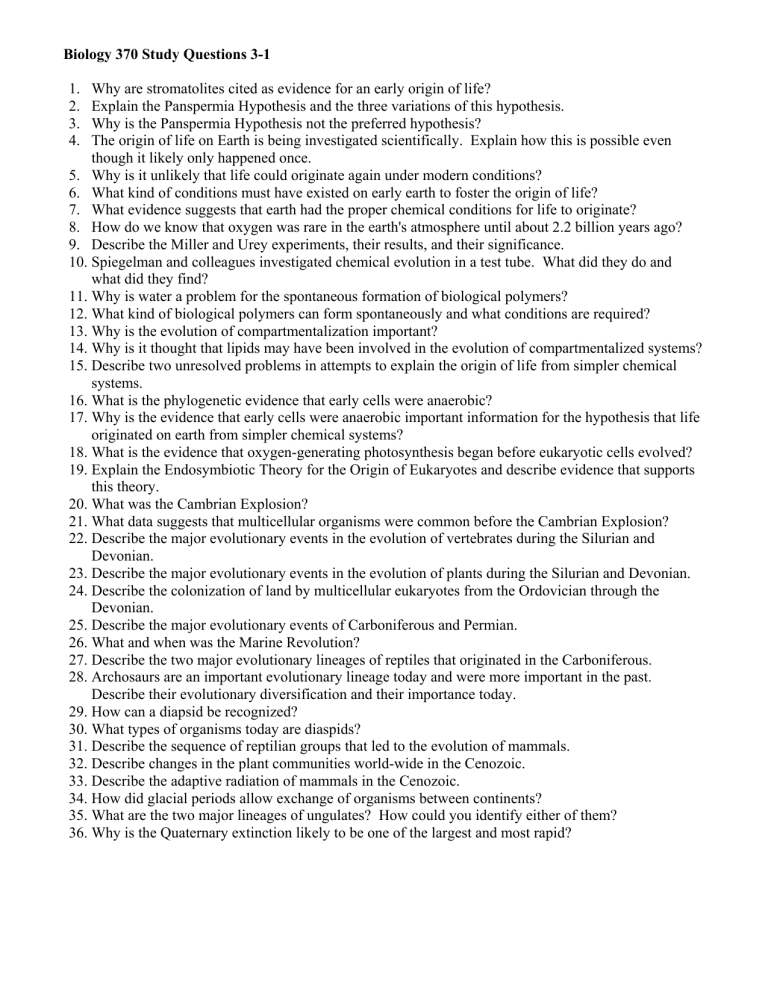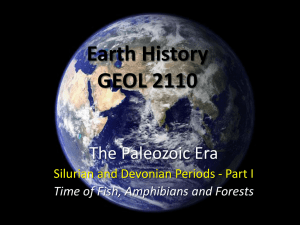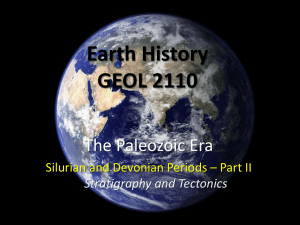Biology 370 Study Questions 3-1

Biology 370 Study Questions 3-1
1.
Why are stromatolites cited as evidence for an early origin of life?
2.
Explain the Panspermia Hypothesis and the three variations of this hypothesis.
3.
Why is the Panspermia Hypothesis not the preferred hypothesis?
4.
The origin of life on Earth is being investigated scientifically. Explain how this is possible even though it likely only happened once.
5.
Why is it unlikely that life could originate again under modern conditions?
6.
What kind of conditions must have existed on early earth to foster the origin of life?
7.
What evidence suggests that earth had the proper chemical conditions for life to originate?
8.
How do we know that oxygen was rare in the earth's atmosphere until about 2.2 billion years ago?
9.
Describe the Miller and Urey experiments, their results, and their significance.
10.
Spiegelman and colleagues investigated chemical evolution in a test tube. What did they do and what did they find?
11.
Why is water a problem for the spontaneous formation of biological polymers?
12.
What kind of biological polymers can form spontaneously and what conditions are required?
13.
Why is the evolution of compartmentalization important?
14.
Why is it thought that lipids may have been involved in the evolution of compartmentalized systems?
15.
Describe two unresolved problems in attempts to explain the origin of life from simpler chemical systems.
16.
What is the phylogenetic evidence that early cells were anaerobic?
17.
Why is the evidence that early cells were anaerobic important information for the hypothesis that life originated on earth from simpler chemical systems?
18.
What is the evidence that oxygen-generating photosynthesis began before eukaryotic cells evolved?
19.
Explain the Endosymbiotic Theory for the Origin of Eukaryotes and describe evidence that supports this theory.
20.
What was the Cambrian Explosion?
21.
What data suggests that multicellular organisms were common before the Cambrian Explosion?
22.
Describe the major evolutionary events in the evolution of vertebrates during the Silurian and
Devonian.
23.
Describe the major evolutionary events in the evolution of plants during the Silurian and Devonian.
24.
Describe the colonization of land by multicellular eukaryotes from the Ordovician through the
Devonian.
25.
Describe the major evolutionary events of Carboniferous and Permian.
26.
What and when was the Marine Revolution?
27.
Describe the two major evolutionary lineages of reptiles that originated in the Carboniferous.
28.
Archosaurs are an important evolutionary lineage today and were more important in the past.
Describe their evolutionary diversification and their importance today.
29.
How can a diapsid be recognized?
30.
What types of organisms today are diaspids?
31.
Describe the sequence of reptilian groups that led to the evolution of mammals.
32.
Describe changes in the plant communities world-wide in the Cenozoic.
33.
Describe the adaptive radiation of mammals in the Cenozoic.
34.
How did glacial periods allow exchange of organisms between continents?
35.
What are the two major lineages of ungulates? How could you identify either of them?
36.
Why is the Quaternary extinction likely to be one of the largest and most rapid?






